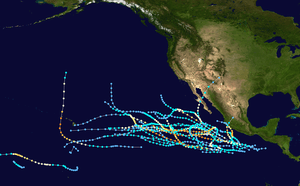Hurricane Iniki
Hurricane Iniki (/iːˈniːkiː/ ee-NEE-kee; Hawaiian: ʻiniki meaning "strong and piercing wind") was the most powerful hurricane to strike the U.S. state of Hawaii in recorded history.[1] Forming on September 5, 1992, during the strong 1990–1995 El Niño, Iniki was one of eleven Central Pacific tropical cyclones during that season. It attained tropical storm status on September 8 and further intensified into a hurricane the next day. After turning north, Iniki struck the island of Kauaʻi on September 11 at peak intensity; it had winds of 145 mph and reached Category 4 status on the Saffir–Simpson hurricane scale. It had recorded wind gusts of 225 as evidenced by an anemometer that was found blown into the forest during clean up. It was the first hurricane to hit the state since Hurricane Iwa in the 1982 season, and the first major hurricane since Hurricane Dot in 1959. Iniki dissipated on September 13 about halfway between Hawaii and Alaska.
| Category 4 major hurricane (SSHWS/NWS) | |
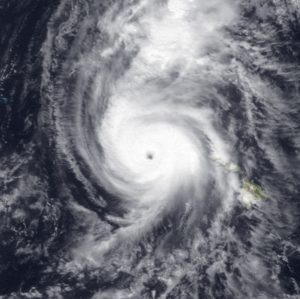 Hurricane Iniki at peak intensity just south of KauaʻI on September 11 | |
| Formed | September 5, 1992 |
|---|---|
| Dissipated | September 13, 1992 |
| Highest winds | 1-minute sustained: 145 mph (230 km/h) |
| Lowest pressure | 938 mbar (hPa); 27.7 inHg |
| Fatalities | 6 total |
| Damage | $3.1 billion (1992 USD) |
| Areas affected | Hawaii (particularly Kauaʻi) |
| Part of the 1992 Pacific hurricane season | |
Iniki caused around $3.1 billion (1992 USD) in damage and six deaths, making it the costliest natural disaster on record in the state, and the second-costliest Pacific hurricane on record. At the time, Iniki was among the costliest United States hurricanes. The storm struck just 18 days after Hurricane Andrew, the costliest tropical cyclone ever at the time, struck Florida.
The Central Pacific Hurricane Center (CPHC) failed to issue tropical cyclone warnings and watches 24 hours in advance. Despite the lack of early warning, only six deaths ensued. Damage was greatest on Kauaʻi, where the hurricane destroyed more than 1,400 houses and severely damaged more than 5,000. Though not directly in the path of the eye, Oʻahu experienced moderate damage from wind and storm surge.
Meteorological history
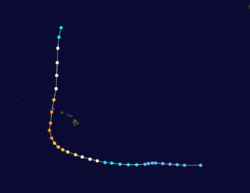
The origin of Iniki is unclear, but it possibly began as a tropical wave that exited the African coast on August 18. It moved westward across the unfavorable Atlantic Ocean and crossed Central America into the Pacific on August 28. The wave continued rapidly westward and remained disorganized. Conditions slowly became more favorable, and, as the convection concentrated around a center, the wave was classified Tropical Depression Eighteen-E on September 5. At this time, the wave was located 1700 miles (2700 km) southwest of Cabo San Lucas or 1550 miles (2500 km) east-southeast of Hilo.[1] Initially, the thunderstorm activity was not concentrated towards the center and thus the depression was not expected to intensify beyond minimal tropical storm strength.[2] The depression continued quickly westward and remained weak until September 8, when it slowed enough to strengthen to a tropical storm.[1] Located at the southern periphery of a subtropical ridge, Iniki continued westward and strengthened over the unusually favorable central Pacific; it reached hurricane status on September 9 while 470 miles (760 km) south-southeast of Hilo. The subtropical ridge, which typically keeps hurricanes well away from the Hawaiian Islands, weakened due to an approaching upper level-trough and allowed Iniki to turn to the northwest. With very favorable upper-level outflow and warm water temperatures, Iniki steadily intensified, and attained major hurricane status on September 10 while south-southwest of the island chain.[1]
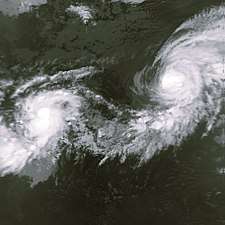
As Iniki turned to the north, it continued to strengthen, reaching a peak of 145 mph (235 km/h) winds on September 11 while 170 miles (270 km) south-southwest of Poʻipū on the island of Kauaʻi. It continued rapidly to the north-northeast, and made landfall on south-central Kauai early on the 11th with sustained winds of 145 mph (235 km/h), making Iniki a Category 4 hurricane on the Saffir-Simpson Hurricane Scale. The National Weather Service reported wind gusts of up to 175 mph (280 km/h). The highest recorded wind speed from Hurricane Iniki was a 227 mph (365 km/h) reading[3] from the Navy's Makaha Ridge radar station. According to the Honolulu Advertiser, that remarkable figure was recorded at a digital weather station whose wind gauging equipment blew off after taking the measurement during the storm. After crossing the island, Iniki rapidly accelerated north-northeastward, weakened rapidly, and was absorbed by a cold front as it lost tropical characteristics and became extratropical, on September 13, about halfway between Alaska and Hawaiʻi.[1]
Preparations
The Central Pacific Hurricane Center (CPHC) failed to issue tropical cyclone warnings and watches for the hurricane well in advance. For several days prior to the disaster, the CPHC and the news media forecast Iniki to remain well south of the island chain, with the only effect being some high surf conditions. Some of the standard international computer models were indicating a northward turn towards the populated Hawaiian Islands, but these were rejected by the CPHC forecasters. As late as early September 10, the CPHC suggested that Iniki would remain well to the south of the island group. It was not until a special bulletin was issued by the CPHC less than 24 hours before landfall—that any warning was given to the public.[4]
A hurricane watch was issued for Kauaʻi early on September 11 and was upgraded to a hurricane warning later that day.[1] Prior to Iniki's arrival in Kauaʻi, 8,000 people were housed in shelters, many of whom remembered Hurricane Iwa 10 years prior.[5] Because schools were canceled, traffic was light during the evacuation, and streets were clear by mid-morning. Rather than sending tourists to public shelters, two major hotels kept their occupants in the buildings during the storm's passage.[5]
The CPHC issued a tropical storm warning for Oʻahu on September 11 which was upgraded to a hurricane warning later that day.[1] Though not hit by the hurricane, Iniki's large wind field caused nearly 30,000 people to evacuate to 110 public shelters in Oʻahu. Public school buildings acted as shelters, and were for refuge only, meaning they did not provide food, cots, blankets, medications or other comfort items. Roughly one-third of Oʻahu's population participated in the evacuation, though many others went to the house of a family member or friend for shelter. The execution of the evacuations went well, beginning with the vulnerable coastal area. For those in need, vans and buses gave emergency transportation, while police manned certain overused intersections. The two main problems that occurred during the evacuation were lack of parking at shelters and exit routes for the coastlines.[5]
Impact
| Storm | Season | Damage | Ref. |
|---|---|---|---|
| Manuel | 2013 | $4.2 billion | [6] |
| Iniki | 1992 | $3.1 billion | [7] |
| Odile | 2014 | $1.25 billion | [8] |
| Agatha | 2010 | $1.1 billion | [9] |
| Willa | 2018 | $825 million | [10][11][12][13] |
| Madeline | 1998 | $750 million | [14] |
| Rosa | 1994 | $700 million | [15] |
| Paul | 1982 | $520 million | [16][17][18] |
| Octave | 1983 | $512.5 million | [19][20] |
| Norman | 1978 | $500 million | [21] |
Hurricane Iniki was the costliest hurricane to strike the state of Hawaiʻi, causing $3.1 billion in damage.[7] Most damage was on the island of Kauaʻi, where the storm destroyed thousands of homes and left a large amount of the island without power, although Oʻahu also suffered significant damage. Iniki also was responsible for six deaths.[1]
The hurricane nearly struck the Central Pacific Hurricane Center in Honolulu. Had it hit there, Iniki, along with Hurricane Andrew and Typhoon Omar, would have struck each of the three National Weather Service offices responsible for tropical cyclone warnings within a two-month period.[4]
Kauaʻi
Hurricane Iniki made landfall on the south-central portion of Kauaʻi island, bringing its dangerous inner core to the entire island.[1] Upon making landfall the hurricane produced storm tides of 4.5–6 feet (1.4–1.8 m), with some portions of the coastlines having high-water marks of up to 18 feet (5.5 m). In addition, strong waves of up to 35 feet (10.5 m) in height crashed along the southern coastline for several hours, causing a debris line of more than 800 feet (250 m) inland. Because it moved quickly through the island, there were no reports of significant rainfall.[5]

Hurricane Iniki's making landfall during daylight hours, combined with the popularity of camcorders, led many Kauaʻi residents to record much of the damage as it was occurring. The footage was later used to create an hour-long video documentary.[22] Commercial air service was suspended.[23]
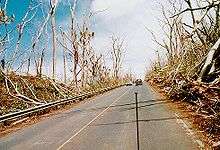
Hurricane Iniki's high winds caused extensive damage in Kauaʻi. 1,421 houses were destroyed, and 63 were lost from the storm surge and wave action. A total of 5,152 homes were severely damaged, while 7,178 received minor damage.[1] On the south coast, hotels and condominiums received severe damage as well. A few were restored quickly, though some took several years to be rebuilt. One hotel—the Coco Palms Resort famous for Elvis Presley's Blue Hawaii—never reopened after the hurricane.[24] Destroyed housing across the island left more than 7,000 people homeless after the storm's passage.[25]
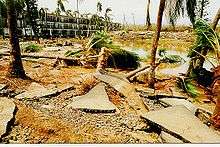
Iniki's high winds also downed 26.5% of the island's transmission poles, 37% of its distribution poles, and 35% of its 800-mile (1300 km) distribution wire system. The entire island lacked electricity and television service for an extended period of time.[25] Electric companies restored only 20% of the island's power service within four weeks of Iniki, while other areas were without power for up to three to four months. Also affected by the storm was the agricultural sector.[1] Though much of the sugar cane was already harvested,[25] what was left was severely damaged. The winds destroyed tender tropical plants like bananas and papayas and uprooted or damaged fruit and nut trees.[1]
Most of Iniki's damage occurred in Kauaʻi. On the island, one person died when struck by debris, while another lost her life when a portion of her house fell on her. Offshore, two Japanese nationals died when their boat capsized. The reduced death toll was likely due to well-executed warnings and preparation. More than 100 injuries can be attributed to Iniki, though most occurred in the aftermath of the hurricane.[1]
Among those on Kauaʻi was filmmaker Steven Spielberg, who was preparing for the final day of on-location shooting of the film Jurassic Park. He and the 130 of his cast and crew remained safely in a hotel during Iniki's passage.[26][27] According to Spielberg, "every single structure was in shambles; roofs and walls were torn away; telephone poles and trees were down as far as the eye could see." Spielberg included footage of Iniki battering the Kaua'i coastal walls as part of the completed film, where a tropical storm makes up a pivotal part of the plot. Members of the film's crew helped to clear some of the debris off of nearby roads.[26]
Oʻahu
Upon passing by Oʻahu, Iniki produced tides of 1.7–3 feet (0.5–0.9 m) above normal.[5] Prolonged periods of high waves severely eroded and damaged the southwestern coast of Oʻahu, with the areas most affected being Barbers Point through Kaʻena.[1] The Waiʻanae coastline experienced the most damage, with waves and storm surge flooding the second floor of beachside apartments.[28] In all, Hurricane Iniki caused several million dollars in property damage,[5] and two deaths on Oʻahu.[1]
Big Island
Damage on the Island of Hawai‘i was minor. Seas of 10 ft (3.0 m) were reported, along with 40 mph (65 km/h) winds.[29] In Honokōhau Harbor, three or four sailboats were tossed onto the rocks and one trimaran at another harbor was sunk. A beach near Napoʻopoʻo on Kealakekua Bay lost some sand and to this day has never been the same.[30]
Aftermath
| Hurricane | Season | Wind speed | Ref. |
|---|---|---|---|
| Patricia | 2015 | 150 mph (240 km/h) | [31] |
| Madeline | 1976 | 145 mph (230 km/h) | [32] |
| Iniki | 1992 | [1] | |
| Twelve | 1957 | 140 mph (220 km/h) | [33] |
| "Mexico" | 1959 | [33] | |
| Kenna | 2002 | [34] | |
| Olivia | 1967 | 125 mph (205 km/h) | [33] |
| Tico | 1983 | [35] | |
| Lane | 2006 | [36] | |
| Odile | 2014 | [37] | |
| Olivia | 1975 | 115 mph (185 km/h) | [38] |
| Liza | 1976 | [32] | |
| Kiko | 1989 | [39] | |
| Willa | 2018 | [40] |

Immediately after the storm, many were relieved to have survived the worst of the Category 4 hurricane; their complacency turned to apprehensiveness due to lack of information, as every radio station was out and there was no news available for several days. Because Iniki knocked out electrical power for most of the island, communities held parties to necessarily consume perishable food from unpowered refrigerators and freezers. Though food markets allowed those affected to take what they needed, many Kauaʻi citizens insisted on paying. In addition, entertainers from all of Hawaiʻi, including Graham Nash (who owns a home on the north shore of Kauaʻi) and the Honolulu Symphony, provided free concerts to the victims.[24]
The film Jurassic Park was being filmed at the time; the sets used for the deleted scene where Mr. Arnold goes to the shed to turn the power on were destroyed, and the cast and crew took shelter in a hotel. Shots of Iniki made it in to the final film. Looting occurred in the aftermath of Iniki, though it was very minor. A group of Army Corps of Engineers, who experienced the looting of Hurricane Andrew just weeks before, were surprised at the overall calmness and lack of violence on the island. Although electrical power was restored to most of the island approximately six weeks following the hurricane, students returned to Kauaʻi public schools two weeks after the disaster. Kauaʻi citizens remained hopeful for monetary aid from the government or insurance companies, though after six months they felt annoyed with the lack of help.[24] The military effectively provided aid for their immediate needs, though, and help arrived before local officials requested aid.[41]
Amateur radio proved to be extremely helpful during the three weeks after the storm, with volunteers coming from the neighboring islands as well as from around the Pacific to assist in the recovery. There was support of local government communications in Lihue in the first week of recovery [28] as well as a hastily organized effort by local operators to assist with the American Red Cross and their efforts to provide shelters and disaster relief centers across Kauaʻi.[42]
In the months after the storm, many insurance companies left Hawaiʻi. To combat this, State Governor John D. Waihee III enacted the Hurricane Relief Fund in 1993 to help unprotected Hawaiʻi residents. The fund was never needed for another Hawaiʻi hurricane, and it was stopped in 2000 when insurance companies returned to the island.[43]
It is thought that Hurricane Iniki blew apart many chicken coops, some possibly used to house fighting chickens; this caused a dramatic increase in the numbers of feral chickens roaming Kauaʻi.[44]
Retirement
The name Iniki was retired due to this storm's impacts, and was replaced with Iolana in the Central North Pacific tropical storm list.[45] Less than three days after Iniki struck, Hurricane Orlene struck the Big Island as a tropical depression, hampering relief efforts.
See also
- List of Hawai'i hurricanes
- List of Pacific hurricanes
- List of retired Pacific hurricane names
- List of Category 4 Pacific hurricanes
- Typhoon Higos (2002) – a storm that took a very similar trajectory to that of Iniki, albeit thousands of miles west of Hawaii, becoming one of the strongest typhoons to strike Tokyo
- Hurricane Lane (2018) – another powerful storm that threatened to strike Hawaii as a strong hurricane, but instead turned westward out to sea, bringing record amounts of rainfall to the islands
- Hurricane Walaka (2018) – took a similar track, making a 90° northward turn under the influence of an upper level trough, but stayed to the west of the main Hawaiian islands
References
- Central Pacific Hurricane Center (1993). The 1992 Central Pacific Tropical Cyclone Season (Report). Honolulu, Hawaii: National Oceanic and Atmospheric Administration. Retrieved November 24, 2003.
- Tropical Depression Eighteen-E Discussion 2 (Report). Archived from the original on February 19, 2016. Retrieved September 8, 2012.
- "Devastated Isle Is On The Mend". chicagotribune.com. Archived from the original on August 22, 2018. Retrieved April 7, 2018.
- Ronald H. Brown (1993). "Natural Disaster Survey Report: Hurricane Iniki" (PDF). Archived (PDF) from the original on February 8, 2012. Retrieved March 13, 2006.
- US Army Corps of Engineers (1993). "Hurricane Iniki Assessment" (PDF). US Military. Archived (PDF) from the original on December 23, 2014. Retrieved March 13, 2006.
- Jakubowski, Steve; Krovvidi, Adityam; Podlaha, Adam; Bowen, Steve. "September 2013 Global Catasrophe Recap" (PDF). Impact Forecasting. AON Benefield. Retrieved October 25, 2013.
- Costliest U.S. tropical cyclones tables update (PDF) (Report). United States National Hurricane Center. January 12, 2018. Archived (PDF) from the original on January 26, 2018. Retrieved January 12, 2018.
- Albarrán, Elizabeth (December 10, 2014). "Aseguradores pagaron 16,600 mdp por daños del huracán Odile" [Insurers paid 16,600 MDP for Hurricane Odile damages]. El Economista (in Spanish). Retrieved February 28, 2015.
- Beven, Jack (January 10, 2011). "Tropical Storm Agatha Tropical Cyclone Report" (PDF). National Hurricane Center. Retrieved January 14, 2011.
- "Hay daños evidentes en Lerdo por lluvias" [There is obvious damage in Lerdo due to rain]. El Siglo de Durango (in Spanish). November 3, 2018. Retrieved November 4, 2018.
- Piña, Ireri (October 25, 2018). "Necesarios 35 mdp para solventar daños por "Willa"" [35 MDP required to address damages by "Willa"]. Contramuro (in Spanish). Retrieved October 26, 2018.
- "Estiman en 6 mil millones de pesos los daños dejados por huracán Willa en Escuinapa". Noticias Digitales Sinaloa (in Spanish). February 6, 2019. Retrieved February 10, 2019.
- Espinosa, Gabriela (November 11, 2018). "Ascienden a $10 mil millones los daños que causó 'Willa' en Nayarit". La Jornada (in Spanish). Retrieved January 14, 2019.
- United States Department of Commerce (1999). "South Texas Floods- October 17 – 22, 1998" (PDF). Retrieved February 11, 2007.
- "Floods in Southeast Texas, October 1994" (PDF). United States Geological Survey. January 1995. p. 1. Retrieved October 1, 2008.
- "Guatemala - Disaster Statistics". Prevention Web. 2008. Archived from the original on July 22, 2011. Retrieved April 12, 2010.
- "5 day toll in El Salvador, 630 killed, crops, destroyed". Anchorage Daily Times. September 23, 1982. Retrieved August 5, 2011.
- "El Salvador Death Toll hits 565 as more bodies found". September 22, 1982. Retrieved August 5, 2011.
- Tucson, Arizona National Weather Service (2008). "Tropical Storm Octave 1983". National Weather Service. Retrieved July 12, 2013.
- Rotzull, Brenda (October 7, 1983). "Domestic News". United Press International. – via Lexis Nexis (subscription required)
- Oard, Michael (March 1, 2015). The New Weather Book (Wonders of Creation). Master Books. p. 54. ISBN 0890518610.
- "ドッグフードにある栄養素". www.video-hawaii.com. Archived from the original on June 22, 1997. Retrieved April 7, 2018.
- "Big Waves at Waikiki but Oahu Is Mostly Spared". The New York Times. September 13, 1992. Archived from the original on September 12, 2017. Retrieved February 16, 2017.
- Anthony Sommer (2002). "The people of Kauai lived through a nightmare when the powerful storm struck". Honolulu Star-Bulletin. Archived from the original on March 11, 2006. Retrieved March 13, 2006.
- Unknown (1992). "Broadcast Journalism: Write to the Bite". Unknown. Archived from the original on February 16, 2012. Retrieved March 13, 2006.
- Shay, Don; Duncan, Jody (June 1993). The Making of Jurassic Park. Ballantine Books. pp. 85–87. ISBN 0-345-38122-X.
- Al Kamen (September 13, 1992). "Hawaii Hurricane Devastates Kauai". Washington Post. Archived from the original on November 6, 2012. Retrieved March 13, 2006.
- Ron Hashiro (1993). "Hurricane Iniki Rallies Amateurs". American Amateur Radio Relay League, Inc. Archived from the original on August 2, 2015. Retrieved March 13, 2006.
- Al Kamen (September 13, 1992). "Hawaii Hurricane Devastates Kauai: Iniki Blamed For 3 Deaths, Scores of Injuries". The Washington Post. Archived from the original on November 6, 2012. Retrieved September 8, 2012.
- "Big Island Hawaii Beaches". big-island-bigisland.com. Archived from the original on October 28, 2014. Retrieved September 8, 2012.
- Kimberlain, Todd B.; Blake, Eric S.; Cangialosi, John P. (February 1, 2016). Hurricane Patricia (pdf) (Report). Tropical Cyclone Report. Miami, Florida: National Hurricane Center. Retrieved February 4, 2016.
- Emil B., Gunther (April 1977). "Eastern North Pacific Tropical Cyclones of 1976". Monthly Weather Review. Eastern Pacific Hurricane Center. 105 (4): 508–522. Bibcode:1977MWRv..105..508G. doi:10.1175/1520-0493(1977)105<0508:EPTCO>2.0.CO;2. Retrieved October 11, 2011.
- Blake, Eric S; Gibney, Ethan J; Brown, Daniel P; Mainelli, Michelle; Franklin, James L; Kimberlain, Todd B; Hammer, Gregory R (2009). Tropical Cyclones of the Eastern North Pacific Basin, 1949-2006 (PDF). Archived from the original on July 28, 2013. Retrieved June 14, 2013.
- Franklin, James L. (December 26, 2002). Hurricane Kenna (pdf) (Report). Tropical Cyclone Report. Miami, Florida: National Hurricane Center. Retrieved October 11, 2011.
- Emil B., Gunther; Cross, R. L. (July 1984). "Eastern North Pacific Tropical Cyclones of 1983". Monthly Weather Review. Eastern Pacific Hurricane Center. 112 (7): 1419–1440. Bibcode:1984MWRv..112.1419G. doi:10.1175/1520-0493(1984)112<1419:ENPTCO>2.0.CO;2. Retrieved October 11, 2011.
- Knabb, Richard D. (November 30, 2006). Hurricane Lane (pdf) (Report). Tropical Cyclone Report. Miami, Florida: National Hurricane Center. Retrieved October 11, 2011.
- Cangialosi, John P.; Kimberlain, Todd B. (December 19, 2014). Hurricane Odile (pdf) (Report). Tropical Cyclone Report. Miami, Florida: National Hurricane Center. Retrieved March 4, 2015.
- Robert A., Baum (April 1976). "Eastern North Pacific Tropical Cyclones of 1975". Monthly Weather Review. Weather Service Forecast Center. 104 (4): 475–488. Bibcode:1976MWRv..104..475B. doi:10.1175/1520-0493(1976)104<0475:ENPTCO>2.0.CO;2. Retrieved October 11, 2011.
- Mayfield, Britt Max (November 18, 1989). Hurricane Kiko (Report). Preliminary Report. Miami, Florida: National Weather Service. p. 6. Retrieved October 11, 2011.
- Brennan, Michael J. (April 2, 2019). Hurricane Willa (pdf) (Report). Tropical Cyclone Report. Miami, Florida: National Hurricane Center. Retrieved April 3, 2019.
- J. Dexter Peach (1993). "What Hurricane Andrew Tells Us About How To Fix FEMA". United States General Accounting Office. Archived from the original on July 8, 2006. Retrieved March 18, 2006.
- Greg Pool (1993). "Iniki and the American Red Cross". Worldradio. 22 (12): 1, 18–20. Archived from the original on January 10, 2005. Retrieved December 17, 2007.
- "State should keep hurricane fund intact for next disaster". Honolulu Star-Bulletin. 2001. Archived from the original on September 22, 2005. Retrieved March 18, 2006.
- "Something's killing off Kauai chickens". Honolulu Advertiser. 2007. Archived from the original on June 7, 2015. Retrieved October 2, 2007.
- "Answers archive: Hurricane history and climatology". USA Today. USAToday.com. 2011. Archived from the original on May 15, 2015. Retrieved November 8, 2013.
